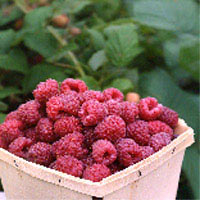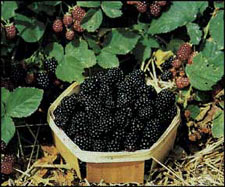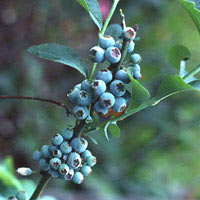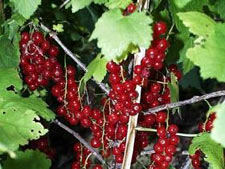
Red raspberries produce a main crop in midsummer, while some varieties such as 'Heritage' produce a second crop in fall.

Blackberries make the perfect edible hedge, keeping unwanted visitors out of your yard while yielding quarts of rich, flavorful berries.

Not only will blueberries produce an abundance of fruits in late summer, the foliage turns a brilliant red in autumn, adding to the fall foliage show.

Red currants make an attractive shrub while producing juicy, tart fruits that are great for jams, jellies, and juice.
Also, many of these berries make excellent shrubs and hedges. Grow blueberries, currants, and gooseberry bushes as foundation plantings along your house or as an informal hedge in the backyard. Grow thorny brambles, such as blackberries and red raspberries, along a fence or wall or as a hedge to keep cats, dogs, and wildlife out of your yard. The fruits on these bushes are attractive even if you don't like the flavor. Birds and other wildlife will enjoy any you forget to harvest. Also, the foliage of some berry shrubs, such as blueberries, turn a brilliant color in the fall.
Why Berries?
Compared with apples, peaches, or any of the tree fruits, bush and bramble fruits are easy to grow. They rarely require spraying for pests, and they begin bearing some fruit the year after planting. By their third season they should be in full production. Perhaps most important, they're very space efficient. None require a mix of varieties for cross-pollination.Berry Basics
With the right culture, berries will reward you handsomely. First, aim for a mix of different types to extend the harvest season, then plant small numbers of each kind and care for them well. Buy the smallest number of plants you can as you're learning.Incorporate lots of organic matter before planting, and mulch with shredded leaves or compost every year. Prune regularly through the season to keep each branch or cane as productive as possible. Here are some specifics on growing these delicious, attractive fruits.
Gooseberries
Gooseberries grow on dense bushes that reach 2 to 4 feet tall without training. They're hardy throughout most of the United States except in the southwestern deserts and the inland valleys of California. Best fruit production occurs in the mid-Atlantic and northeastern U.S.Gooseberries leaf out early in spring. The foliage is a lustrous green, turning bronze to red in fall. Branches are covered with straight, 1-inch-long spines. The ripe fruit is either translucent yellow-green or dusky purple to red, depending on the variety. When ripe, the fruit is juicy and sweet with a pleasing acidity. As with any fruit, there are marked varietal differences in flavor.
Gooseberries are one of the few fruits that hold their quality well on the bush when ripe. The earliest gooseberries (which can be picked green) fill the brief gap between the last strawberries and the first red raspberries. When the berries reach about 1/2 inch in diameter and are still hard and a month from being ripe, they're excellent for pies and other cooked desserts. This early harvest thins the fruit so the ripe berries will be larger.
Gooseberries, especially the unripe fruit, are high in pectin; you can make very thick jam with no added pectin. A mature plant can produce from 5 to 8 quarts of fruit, so one plant may be all you need. Where space is extremely limited, train gooseberries against walls as fan-shaped or horizontal espaliers. These espaliers provide year-round interest, and picking will be easier, too.
Gooseberries bear fruit near the base of 1-year-old shoots and on short spurs on older wood. So no matter how carelessly one prunes, there's always some fruit. Remove about 20 percent of the oldest growth — wood that's been growing for three to five seasons — each year. Also cut out enough of the newest growth to make the plant open and easy to pick. Always save some vigorous new shoots to become future main branches. Any new shoot can be cut back to 4 to 6 inches with little loss in fruiting potential.
Red Raspberries
A 30-foot row of raspberries, trained to single stems against a wall or fence, will yield about a quart of fruit every other day for three weeks, and that's plenty of raspberries for most people. A more traditional hedge-type planting will yield twice that amount, although it takes at least twice the space. Intensively trained berries are extremely productive. To get the most from red raspberries, plant at least two kinds: a main crop variety for heavy early summer harvests, and a fall (or everbearing) type to close out the berry harvest. Where the season is long, you may need to plant two fall varieties to keep you picking until frost.The popular 'Heritage' variety, for example, will be finished in early September in USDA Zone 6, with about four weeks of potential ripening weather left. It's a mistake to cut raspberry canes back in an effort to make the canes self-supporting. The most fruitful buds are those nearest the top of the canes. You'll get the best results by tying the canes to two wires at 2-1/2 and 5 or 6 feet off the ground, depending on the vigor of the variety. Main-crop raspberries fruit on 1-year-old canes. After harvest, cut them out at ground level to favor the new canes. When you've got vigorous new canes growing about 6 inches apart, remove any new ones that appear through the growing season.
Fall raspberries fruit on new canes at the end of their first growing season and again the following summer. For heavier fall crops, prune the canes to the ground after the first harvest in autumn and forego the summer crop from fall varieties.
Black Raspberries
Although closely related to the reds, blackcaps have a distinctive flavor, ripen a little later, and require slightly different training. Black raspberries spread by bending the tips of their canes to the ground where they root, leapfrogging along at 2 to 3 feet a year. New shoots arise only from the original crowns, not willy-nilly from the roots as with red raspberries. Also, there are no fall-fruiting black raspberries. In most other respects, they're very similar to the reds. In an attempt to bend to the ground and root, the canes elongate and become thin and weak at the tips. Unless you want to start new plants, cut these canes back to 3 or 4 feet. They'll be self-supporting, with no loss of fruiting potential. Cut the old canes out after harvest. Since black raspberries don't throw root suckers, they take much less thinning than reds.Currants: Black, White, and Red
Judging by flavor alone, most people would regard currants as two totally different fruits: the fresh, tart reds and whites versus the strangely pungent and heavy blacks. But they're close botanical relatives, and because they ripen about the same time and their culture is almost identical, it's best to consider them together.Red currants are one of the most beautiful fruits. When the berries are ripe, the plant literally drips with long clusters of gleaming scarlet beads. Each red berry (white currants are just a different color variation) has a transparent skin, so sunlight makes it glow from within. Currants are very juicy and quite tart. When fully ripe, you can enjoy them right off the bush, the way you would eat any other berry. Traditionally, currants are used for jelly, jam, and cooked desserts. Ripe currants will hold on the bush for much longer than most other fruits without dropping or losing quality.
Black currant bushes are slightly larger than red currants, and the fruits are not as conspicuous. Black currants are meatier, less juicy, and when eaten fresh they're definitely an acquired taste. Cooked, however, they lose their musky overtones and make one of the finest-flavored jams of all.
Blackberries
Blackberry culture began in North America, although there are flavorful species native to Europe and Asia. Today's improved varieties have mixed heritage, part American natives and part Eurasian species. Blackberries are far and away the heaviest bearing of the bramble fruits, producing about twice as much as red raspberries. They ripen in midsummer after the raspberries are finished, and are more heat tolerant than raspberries.Blackberries are robust plants that need to be restrained or they can become weeds. They grow and can be trained much like red raspberries. However, since they throw root suckers so vigorously, you may want to confine their roots with metal or fiberglass barriers sunk 1 foot or more below ground level.
Blackberries are much more thorny than reds or blackcaps. Where space is restricted, or if you don't have the patience to pick fruit from these prickly plants, choose one of the relatively new thornless varieties, such as 'Chester'. Many of these are trailing in habit, so you'll need to rig a wire trellis to train them up. There are also new blackberry varieties that fruit on the first year canes similar to everbearing red raspberries. 'Prime Jim' and 'Prime Jan' produce in late summer the first year and can be mowed down each fall for easy maintenance.
Blueberries
Blueberries are a relatively new fruit, domesticated only within the last 75 years. They probably would have been tamed sooner if people had understood their need for an acid soil. Brought from American wild lands into gardens, the fruits almost always died because the soil had been limed. Blueberries demand a soil pH between 4.0 and 5.5. Correct the pH for blueberries with peat moss (mixed at least 50/50 with your native soil) and perhaps some soil sulfur. The bushes have extremely shallow root systems, so the heavy peat blend need not be deeper than 12 inches. Blueberries need a steady supply of moisture; the water-retentive peat will help with that as well.One blueberry bush is all you need. In its fourth season it will produce a pint or so of fruit. At maturity, when it's 4 to 6 feet tall, the right variety can produce up to 20 pints over two to three weeks. However, if you've room for three or four varieties, you can stretch the harvest to 8 to 10 weeks, into the fall raspberry season. Although cross-pollination isn't essential, it will encourage larger fruit.
Blueberries are extremely handsome shrubs, notable for their brilliant fall color and bright stems in winter. Some of the newer varieties are low and shrubby. These half-high varieties, such as 'Northland', make excellent shrubs to work into a perennial border or a low-growing flower bed. For gardeners in warmer climates, try growing Southern blueberry varieties, such as 'Misty', or rabbiteye blueberries, such as Tifblue'. These are more adapted to the summer heat.
When planting in the landscape, keep blueberry bushes away from masonry walls and foundations, where the soil can be excessively alkaline. If you mix them into a shrub border or with other plants, be sure to amend the soil pH so they can thrive. Other than netting to keep birds away, they are carefree fruits that will give you years of production. http://www.garden.org/ediblelandscaping/?page=berry-shrubs
No comments:
Post a Comment